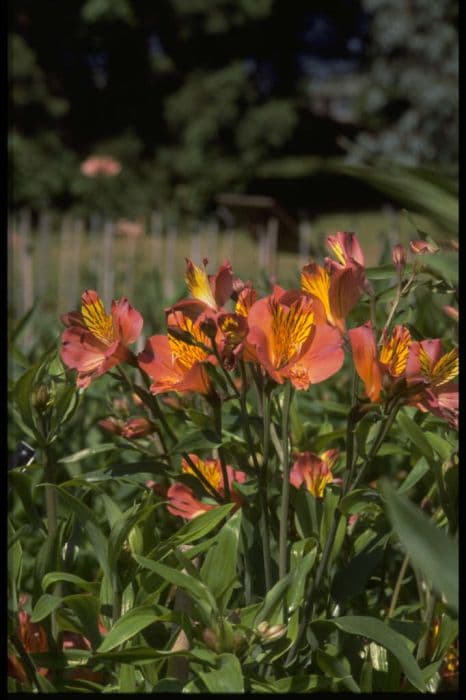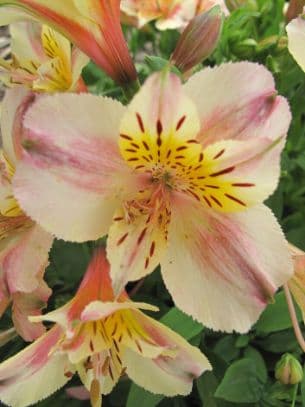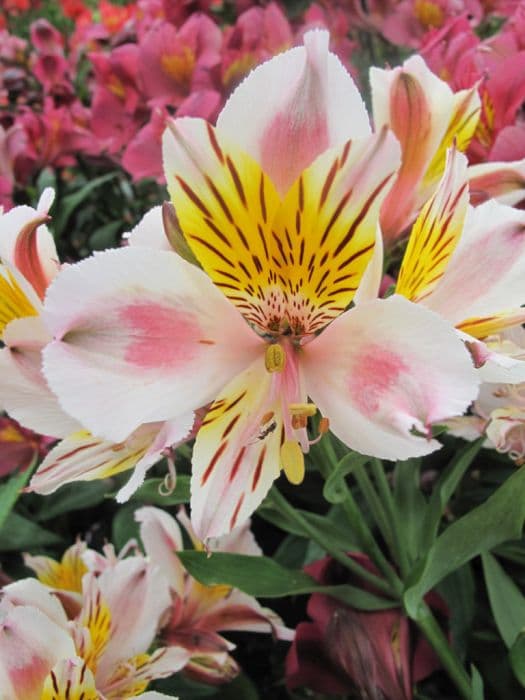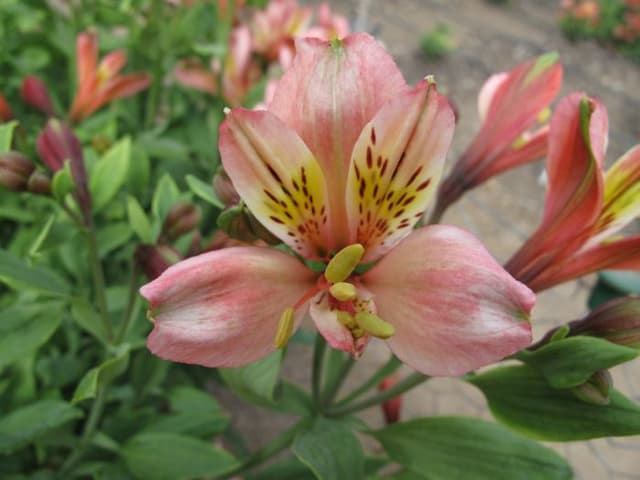Peruvian Lily Alstroemeria Princess Fabiana = 'Zaprifabi' (PBR) (Princess Series)
![Peruvian lily [Princess Fabiana]](/_next/image?url=https%3A%2F%2Fplants-admin.emdemapps.com%2Fimages%2Fplants%2F%2Fimages%2F604b58855f4ed.png&w=3840&q=75)
ABOUT
Alstroemeria Princess Fabiana, commonly known as Peruvian Lily or Lily of the Incas, is a strikingly beautiful ornamental plant that is part of the 'Princess Series'. It is characterized by its bountiful clusters of elegant flowers, which boast a unique pattern and coloration. The blossoms are predominantly white, which provides a neutral and pure backdrop to the vibrant detailing. What sets these flowers apart are the delicate pink brush strokes that elegantly dance their way across each petal, often deepening in color around the edges and tips, adding depth and contrast to the floral display. The flowers also feature a smattering of golden yellow throats at the center, which creates a stunning warm focal point drawing the eye in. Additionally, each petal exhibits a subtle array of freckles, similar in color to the pink markings, reminiscent of a delicate spray of paint. These spots further enhance the ornamental appeal of the bloom, making each flower appear as if it were intricately hand-painted. The Peruvian Lily has linear to lance-shaped leaves that furl in a spiral fashion along the stem, adding to the visual interest of the plant. The foliage is typically a lively green, providing a lush background that beautifully complements and supports the visual attractiveness of the stunning flowers. Altogether, the intricate detailing and attractive color combination of the flowers, combined with the graceful foliage, make Alstroemeria Princess Fabiana a cherished addition to any garden or floral arrangement, appreciated for its striking decorative qualities.
About this plant
 Names
NamesFamily
Alstroemeriaceae
Synonyms
Inca Lily, Peruvian Lily, Lily of the Incas
Common names
Alstroemeria Princess Fabiana = 'Zaprifabi' (PBR) (Princess Series).
 Toxicity
ToxicityTo humans
The Alstroemeria, commonly known as Peruvian Lily or Lily of the Incas, is not considered highly toxic to humans. However, handling the plant may cause skin irritation or allergic reactions in some individuals due to the presence of tulipalin, a compound found in the plant. If ingested, it could potentially cause mild gastrointestinal upset, but serious cases of poisoning are rare.
To pets
Peruvian Lily can be toxic to pets, particularly cats and dogs, if ingested. It contains a compound known as tulipalin which can cause gastrointestinal upset, including symptoms like vomiting, diarrhea, and abdominal pain. In more severe cases, it may lead to drooling or anorexia. If a pet ingests a significant amount of the plant, it is advisable to seek veterinary attention promptly.
 Characteristics
CharacteristicsLife cycle
Perennials
Foliage type
Evergreen
Color of leaves
Green
Flower color
White
Height
1-2 feet (30-60 cm)
Spread
1-2 feet (30-60 cm)
Plant type
Herb
Hardiness zones
7
Native area
South America
Benefits
 General Benefits
General Benefits- Long-lasting blooms: The flowers of Alstroemeria Princess Fabiana have a long vase life, making them excellent for cut flower arrangements.
- Continuous flowering: This plant typically blooms throughout the summer months, providing consistent color to gardens and landscapes.
- Attracts pollinators: The vibrant flowers attract bees, butterflies, and other pollinating insects, supporting the local ecosystem.
- Diverse colors and patterns: The flowers offer a range of colors and unique patterns, which can add visual interest to any garden setting.
- Low maintenance: Alstroemeria Princess Fabiana is known for being easy to care for, requiring minimal upkeep once established.
- Drought tolerance: The plant has good drought tolerance once established, making it suitable for gardens in drier climates.
- Versatile planting options: It can be planted in borders, containers, or as part of a cutting garden for its decorative flowers.
 Medical Properties
Medical PropertiesThis plant is not used for medical purposes.
 Air-purifying Qualities
Air-purifying QualitiesThis plant is not specifically known for air purifying qualities.
 Other Uses
Other Uses- Alstroemeria Princess Fabiana can be used as a natural dye for fabrics, offering hues ranging from yellows to oranges depending on the mordant used.
- Pressed Alstroemeria petals can be incorporated into handmade paper crafts, providing a unique texture and floral pattern to the paper.
- The long-lasting flowers can be used in the creation of edible cake decorations, after ensuring they have been grown without harmful pesticides.
- Alstroemerias are sometimes used in the art of Ikebana, the Japanese art of flower arrangement, where their vibrant colors and shapes bring a dynamic element to compositions.
- The strong stems of the Alstroemeria Princess Fabiana make them suitable for making lightweight floral crowns or boutonnieres.
- When dried, the petals can be used to make a fragrant and colorful potpourri, often mixed with other dried flowers and spices.
- The flowers can be photographed and used in botanical prints, which are popular for home decoration and as artistic references.
- Landscape architects can use these plants to create color-themed garden designs, as they are available in various colors that remain vibrant throughout the blooming season.
- Their resilience to cooler temperatures can make Alstroemerias a suitable option for temporary outdoor displays even in cooler months.
- Alstroemeria petals can be used in crafting natural confetti for weddings and celebrations, which is biodegradable and environmentally friendly compared to synthetic alternatives.
Interesting Facts
 Feng Shui
Feng ShuiThe Peruvian Lily is not used in Feng Shui practice.
 Zodiac Sign Compitability
Zodiac Sign CompitabilityThe Peruvian Lily is not used in astrology practice.
 Plant Symbolism
Plant Symbolism- Wealth: The lush, full blossoms of the Alstroemeria, commonly known as Peruvian Lily or Lily of the Incas, are often associated with abundance and prosperity.
- Devotion: Peruvian Lilies symbolize the strength of friendships and romantic relationships; their twisted leaves represent the intertwining of two lives.
- Achievement: The vibrant colors and the hardiness of the plant signify achievement of personal aspiration, representing the reaching of one's goals.
- Fortune: As a gift, Peruvian Lilies are believed to bring good luck to whoever receives them.
 Water
WaterPeruvian lily, also known as Alstroemeria Princess Fabiana, should be watered regularly to keep the soil consistently moist but not waterlogged. During the growing season, typically spring through summer, water the plant thoroughly once a week by applying approximately 1 gallon of water per square yard of soil. Reduce watering to every other week during the fall and only water sparingly in winter months to avoid root rot. Ensure the pot has adequate drainage to prevent standing water at the base of the plant.
 Light
LightThe Peruvian lily thrives in bright, indirect light, making it ideal for a spot that receives partial sun—a location with morning sun and afternoon shade, or filtered light throughout the day, is perfect. Avoid harsh midday sun which can scorch the leaves and compromise the health of the plant.
 Temperature
TemperaturePeruvian lilies prefer temperatures between 65 to 80 degrees Fahrenheit during the growing season to perform best. They can survive a temperature as low as 50 degrees Fahrenheit but should not be exposed to frost conditions. It's crucial to keep the plant away from drafts in winter, as well as extreme heat in summer.
 Pruning
PruningPeruvian lily should be pruned to remove spent flowers and dead foliage to encourage new growth and maintain a tidy appearance. Prune the plant lightly after the main blooming cycle, usually in late summer or early fall, to stimulate a second bloom. Pulling the stems from the base rather than cutting can also promote additional flowering.
 Cleaning
CleaningAs needed
 Soil
SoilAlstroemeria, or Peruvian Lily, thrives in fertile, well-draining soil with a pH between 6.5 and 7. The ideal soil mix should consist of equal parts loamy soil, peat or coconut coir, and sharp sand or perlite to ensure proper drainage and root health.
 Repotting
RepottingPeruvian Lilies typically need repotting every two to three years to prevent becoming root-bound and to refresh the soil. It's best to repot in the spring before the growing season.
 Humidity & Misting
Humidity & MistingPeruvian Lilies enjoy moderate humidity levels, around 40-60%. They can tolerate lower humidity but will flourish if the ambient humidity is kept within this range, especially during dry, indoor heating seasons.
 Suitable locations
Suitable locationsIndoor
Place Peruvian Lily in bright, indirect light and ensure good airflow.
Outdoor
Plant in partial shade with shelter from harsh sun.
Hardiness zone
7-10 USDA
 Life cycle
Life cycleAlstroemeria, commonly known as the Peruvian Lily or Lily of the Incas, starts its life cycle as a dormant rhizome or tuber. Once planted, it germinates and produces shoots that grow into stems with lance-shaped leaves. The plant then develops buds that bloom into the characteristic colorful and speckled trumpet-shaped flowers of the 'Princess Fabiana'. After the flowering period, which can last from late spring through early fall, the plant sets seed if pollination occurs, although this cultivar is often propagated vegetatively. Over time, the stems wilt and die back, particularly after the first frost in colder climates, and the plant enters a period of dormancy. With the arrival of warmer temperatures in spring, the plant re-emerges from dormancy, restarting the cycle with new growth from the rhizomes.
 Propogation
PropogationPropogation time
Spring to Summer
The most popular method for propagating the Alstroemeria Princess Fabiana, commonly known as the Peruvian Lily 'Princess Fabiana', is through division. This should ideally be done in the spring when the plant begins to show new growth. During this time, the clumps of rhizomes can be gently dug up and carefully separated, ensuring that each division has at least one growth bud. These divisions can then be replanted immediately in well-draining soil, at a depth of approximately 6 to 8 inches (15 to 20 centimeters), and spaced about 12 to 24 inches (30 to 61 centimeters) apart to allow for proper growth. Regular watering and fertilization will help establish the new plants, which will bloom within a season or two.


![Peruvian lily [Princess Carmina]](/_next/image?url=https%3A%2F%2Fplants-admin.emdemapps.com%2Fimages%2Fplants%2F%2Fimages%2F604b5b436505f.png&w=640&q=75)



![Peruvian lily [Inca Glow]](/_next/image?url=https%3A%2F%2Fplants-admin.emdemapps.com%2Fimages%2Fplants%2F%2Fimages%2F604b5e99e48d9.png&w=640&q=75)
![Peruvian lily [Inca Smile]](/_next/image?url=https%3A%2F%2Fplants-admin.emdemapps.com%2Fimages%2Fplants%2F%2Fimages%2F604b5cad8fa91.png&w=640&q=75)
![Peruvian lily [Inticancha Passion]](/_next/image?url=https%3A%2F%2Fplants-admin.emdemapps.com%2Fimages%2Fplants%2F%2Fimages%2F604b5f7a78c8d.png&w=640&q=75)
